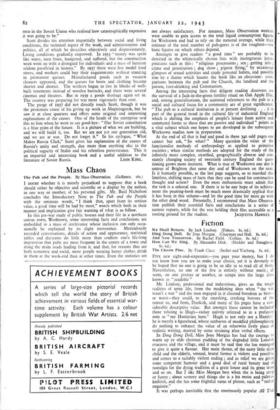Mass Chaos
The Pub and the People. By Mass Observation. (Gollanez. 16s.)
I DOUBT whether it is merely prejudiced to suppose that a book should either be objective and scientific or a display by the author, in one way or another, of his personal gifts. Mr. Basil Nicholson concludes the Introductory Note to The Pub and the People with the ominous words, " I think that, apart from its serious value, a good time will be had by most," words which both in their manner and implication give fair warning of what is to follow.
In this pre-war study of public houses and their life in a northern cotton town, Worktown, some interesting facts and conclusions are embedded in a mass of irrelevance whose inclusion can only occa- sionally be explained by its slight irreverence. Meticulously recorded conversations, details of action and appearance, statistical tables and diagrams do little more than confirm ones life-long impression that pubs are most frequent in the centre of a town and along the main roads leading from it, and that, for reasons that are both economic and social, more people wearing better clothes drink in them at the week-end than at other times. Even the statistics are not always satisfactory. ,For instance, Mass Observation workers were unable to gain access to the total liquid consumption figures for Worktown and had to rely on the national average, while their estimate of the total number of pub-goers is of the roughest—two basic figures on which others depend.
Attempts to give readers " a good time " are probably to be detected in the whimsically chosen lists with incongruous juxta- positions such as this: " religious processions ; sex ; getting jobs ; crime and prostitution ; dog show ; pigeon flying," by occasional glimpses of sexual activities and crude personal habits, and possibly also by a theme which haunts the book like an obsession: com- parisons between the pub and the Church, the landlord and the parson, beer-drinking and Communion. Among the interesting facts that diligent reading discovers are the survival of a Jack-in-the-green-fertility ritual on Oak Apple Day, and, among generalisations, the scattered references to the pub as a social and cultural focus for a community are of great significance. " The pub as a cultural institution is at present declining . . . it is part of the general trend in the cultural life of industrial England which is shifting the emphasis of people's leisure from active and communal forms to those that are passive and individual " points to a vital subject which one hopes to see developed in the subsequent Worktown studies now in preparation.
At the end of all that is bad and good in these 34o odd pages one cannot but ask, " So what? " Many question the value of the functionalist methods of anthropology as applied to primitive societies ; when similar methods are adopted for the study of the infinitely more complex, stratified, geographically diverse and con- stantly changing society of twentieth century England the ques- tioning grows more insistent. What is true of Worktown one day is untrue of Brighton that same day and of Worktown on the next. Is it humanly possible, as the last page suggests, so to marshal this limitless, shifting mass of facts that they can be used for constructive thought and action? Even the most enthusiastic must admit that the task is a colossal one. If there is to be any hope of its achieve- ment the pruning-hook must be much more drastically applied than it has been in this volume—and let the good time for most go with the other dead wood. Personally, I recommend that Mass Observa- tion publish their essential facts and conclusions in a series of austere reports, while for the rest holding their files accessible as a


























 Previous page
Previous page